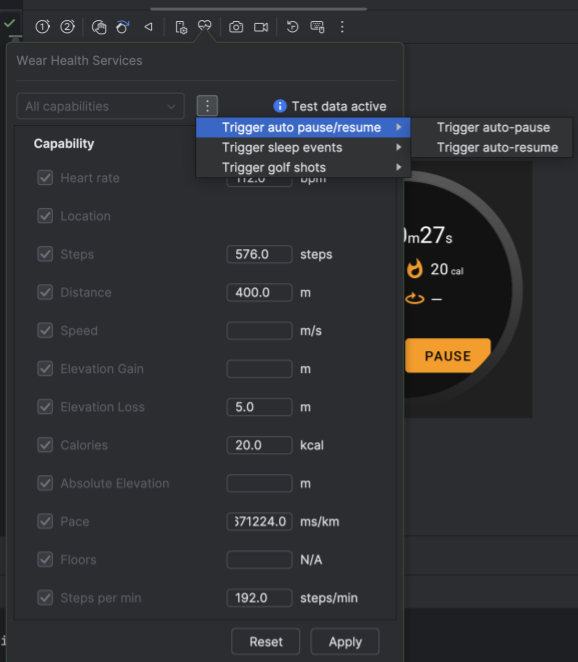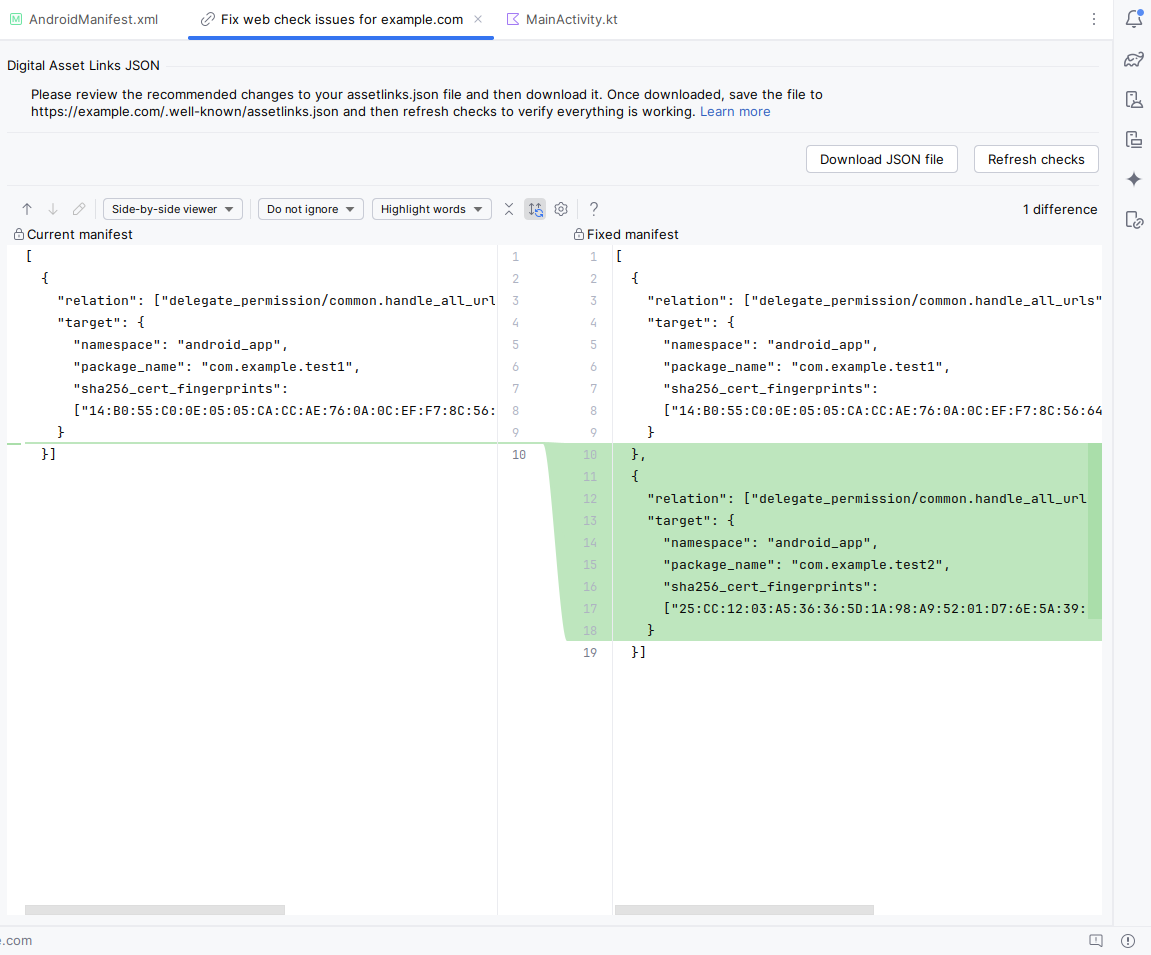في ما يلي الميزات الجديدة في تحديث Ladybug الذي يحتوي على ميزات جديدة من "استوديو Android".
معاينة الصور المتحركة لمربّعات الشاشة على Wear
يتيح الإصدار 2 من Android Studio Ladybug Canary والإصدارات الأحدث الآن معاينة الصور المتحركة في Wear Tiles، ما يسهّل عليك فحص الصور المتحركة للقوائم وتصحيح أخطائها مباشرةً داخل حزمة تطوير البرامج (IDE). تستند هذه الميزة إلى ميزة معاينة شاشة التطبيقات المصغّرة في Wear OS التي تم تقديمها في الإصدار Koala من "استوديو Android".
للبدء:
- يجب تحديث Android Studio إلى الإصدار Ladybug Canary 2 أو إصدار أحدث.
- إضافة مكتبات التطبيقات المصغّرة والأدوات:
- أضِف الملحقات إلى ملف
build.gradle.ktsعلى مستوى التطبيق:# Required for the previews debugImplementation(libs.androidx.tiles.tooling) implementation(libs.androidx.tiles.tooling.preview) # Dependencies needed to build the tiles implementation(libs.androidx.tiles) implementation(libs.androidx.protolayout) implementation(libs.androidx.protolayout.material)
- ملف
libs.versions.toml:[versions] tiles = "1.5.0-alpha01" protolayout = "1.3.0-alpha01" [libraries] androidx-tiles-tooling = { group = "androidx.wear.tiles", name = "tiles-tooling", version.ref = "tiles" } androidx-tiles-tooling-preview = { group = "androidx.wear.tiles", name = "tiles-tooling-preview", version.ref = "tiles" } androidx-tiles = { group = "androidx.wear.tiles", name = "tiles", version.ref = "tiles" } androidx-protolayout = { group = "androidx.wear.protolayout", name = "protolayout-proto", version.ref = "protolayout" } androidx-protolayout-material= { group = "androidx.wear.protolayout", name = "protolayout-material", version.ref = "protolayout" } androidx-protolayout-expression= { group = "androidx.wear.protolayout", name = "protolayout-expression", version.ref = "protolayout" }
- إعداد معاينات لخدمات "اللوحات" يُرجى الرجوع إلى دليل معاينة مربّعات الشاشة للحصول على التعليمات التفصيلية. إذا كانت مربّعاتك تتضمّن صورًا متحركة، ستظهر تلقائيًا معاينة الصور المتحركة، ما يتيح لك فحصها وتصحيح أخطائها.
يعمل هذا التحسين على تبسيط سير عمل تطوير تطبيقات Wear Tile من خلال توفير طريقة مرئية وتفاعلية لتحسين الصور المتحركة للقوائم ضمن "استوديو Android".
إيقاف أداة تعديل الصور المتحركة نهائيًا
في الإصدار القادم، سنوقف نهائيًا استخدام أداة تحرير الصور المتحركة كجزء من عملية النقل الجارية من XML إلى Jetpack Compose. يوفّر تطبيق Compose أسلوبًا أكثر حداثة وفعالية لإنشاء الصور المتحركة، وننصح المطوّرين ببدء استخدام ميزة معاينة الصور المتحركة في Compose لمشاريعهم الجديدة.
الميزات الجديدة في Gemini ضمن "استوديو Android"
يقدّم الإصدار Ladybug من "استوديو Android" عددًا من ميزات "محرر الرموز البرمجية" الجديدة التي تستخدم Gemini لمساعدتك في زيادة إنتاجيتك. لاستخدام هذه الميزات، فعِّل مشاركة سياق الرمز مع Gemini في مشروعك الحالي.
يمكنك استخدام الروابط التالية للاطّلاع على مزيد من المعلومات عن هذه الميزات:
- عمليات تحويل الترميز في Gemini
- إنشاء مستندات
- إعادة التسمية باستخدام Gemini
- إعادة النظر في أسماء المتغيّرات
- إنشاء رسالة الإتمام
دمج أداة Google Play SDK Index
يتضمّن دمج Google Play SDK Index في "استوديو Android" الآن تحذيرات من Google Play SDK Console. يمنحك ذلك نظرة شاملة على أي مشاكل محتملة في الإصدار أو السياسة في التبعيات قبل إرسال تطبيقك إلى Google Play Console.
يعرض "استوديو Android" الآن أيضًا ملاحظات من مؤلفي حِزم SDK مباشرةً في المحرِّر لتوفير الوقت. عندما يتوفّر إصدار أو نطاق إصدار مقترَح، ستشمل IDE أيضًا حلًا سريعًا:

يعرض "استوديو Android" أيضًا تحذيرات عندما يتضمّن إصدار معيّن من حزمة SDK ثغرات أمنية معروفة. تساعدك هذه المعلومات في اكتشاف هذه المشاكل ومعالجتها أثناء تطوير التطبيق حتى تتمكّن من اتّباع أفضل الممارسات.
إمكانات وقيم أداة الاستشعار الوهمية
يتضمّن Android Studio الآن لوحة أجهزة استشعار جديدة تتيح لك محاكاة جهاز يمتلك إمكانات أجهزة استشعار معيّنة أو لا يمتلكها، مثل جهاز استشعار معدل ضربات القلب، بالإضافة إلى ضبط قيم اختبار محدّدة لهذه الأجهزة. استخدِم هذه اللوحة لاختبار كيفية تعامل تطبيقك مع الأجهزة التي تتضمّن إمكانات مختلفة لأجهزة الاستشعار. هذه اللوحة مفيدة لاختبار تطبيقات الصحة واللياقة البدنية، خاصةً على أجهزة Wear OS.

لفتح اللوحة واستخدامها، اتّبِع الخطوات التالية:
- أنشئ جهاز Android افتراضيًا (AVD) أو افتح جهازًا مماثلاً وشغِّل تطبيقك على المحاكي.
- في لوحة المحاكي، اختَر خدمات Wear Health.
 يتم فتح لوحة خدمات Wear Health
، والتي تعرض قائمة بأجهزة الاستشعار المتاحة على مختلف
أجهزة Android.
يتم فتح لوحة خدمات Wear Health
، والتي تعرض قائمة بأجهزة الاستشعار المتاحة على مختلف
أجهزة Android.
بعد فتح اللوحة، يمكنك إجراء ما يلي:
- بدِّل بين الإمكانات العادية أو جميع الإمكانات (الإعداد التلقائي) أو مخصّصة. انقر على تطبيق لإرسال القائمة الحالية للخيارات إلى الجهاز المحاكي، وانقر على إعادة الضبط لمحاولة استعادة قائمة الخيارات إلى قيمها التلقائية "تفعيل" أو "إيقاف".
- يمكنك بدء أحداث مستخدِمين مختلفة بعد اختيار الزرّ المنسدلة بدء الأحداث. من هنا، يمكنك بدء ميزة الإيقاف/الاستئناف التلقائي لأنشطة التمارين الرياضية، وبدء أحداث النوم التي يجريها المستخدم، وبدء لقطات لعبة الجولف التي يجريها المستخدم على ملعب جولف أو ملعب جولف مصغر.
- إلغاء قيم أداة الاستشعار بعد بدء تمرين في تطبيق تم تثبيته على المحاكي بعد إدخال قيم جديدة لمقاييس التمارين المختلفة، انقر على تطبيق لمزامنة هذه القيم مع المحاكي. ويُعدّ ذلك مفيدًا لاختبار كيفية تعامل تطبيقك مع ظروف التمارين المختلفة ومؤشرات اللياقة البدنية للمستخدمين.
"مساعِد روابط التطبيقات": إنشاء ملفات JSON وإصلاح مشاكل الويب
لتنفيذ ميزة "روابط التطبيقات"، على المطوّرين نشر ملف روابط التنقل إلى مواد العرض الرقمية بتنسيق JSON على مواقعهم الإلكترونية لإثبات ملكية النطاق. عندما يرصد "مساعِد روابط التطبيقات" عمليات التحقّق من الويب التي تعذّر إكمالها، ينشئ الآن ملف JSON يمكنه تصحيح هذه الأخطاء. يمكن للمستخدم تنزيل ملف JSON هذا ثم uploadedتحميله بعد ذلك إلى الموقع الإلكتروني المعنيّ لحلّ حالات تعذُّر التحقّق من الويب.
في الحالات التي يتوفّر فيها ملف JSON، يمكن للمستخدمين مقارنة ملفَي JSON الحالي والجديد لتحديد الاختلافات.

لفتح "مساعِد روابط التطبيقات"، انتقِل إلى الأدوات > مساعِد روابط التطبيقات من شريط القوائم الرئيسي.
إشعار عند عدم توفّر خطوة الإنشاء في إعدادات التشغيل
يُعلمك تصحيح الإصدار 1 من ميزة Ladybug في Android Studio والإصدارات الأحدث إذا كانت إعدادات التشغيل النشطة لا تتضمّن خطوة "Make متوافقة مع Gradle". إذا كانت إعدادات التشغيل لا تتضمّن هذه الخطوة، من المحتمل أنّك تأثّرت بمشكلة معروفة تمّت إزالتها في الإصدار 9 من Canary ضمن ميزة Ladybug Feature Drop. لحلّ هذه المشكلة، يمكنك يدويًا إضافة خطوة "Make المتوافقة مع Gradle" في قسم "قبل الإطلاق" ضمن إعدادات إعدادات التشغيل. يمكنك الوصول إلى هذه الصفحة من خلال النقر على تشغيل/تصحيح أخطاء الإعدادات > تعديل الإعدادات.

